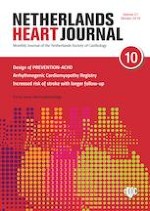-
The majority of recently diagnosed healthy patients with atrial fibrillation (AF) develop cardiovascular diseases, with a consequent change in thromboembolic risk, within a short time frame.
-
The average time to develop a CHA2DS2-VASc score > 1 was roughly only 4 years.
-
Despite an increase in the CHA2DS2-VASc score during follow-up, many initally low-risk patients did not ultimately receive adequate (N)OAC treatment.
-
The mean duration of untreated thromboembolic risk among inadequately treated patients was 5.1 ± 2.8 years.
-
A comprehensive follow-up of AF patients with an initially low thromboembolic risk is necessary to prevent cardiovascular disease progression and to avoid undertreatment with anticoagulant therapy.
Introduction
Methods
Study population
Data collection
Statistical analysis
Results
Cardiovascular disease during follow-up
sinus rhythm (n = 45) | atrial fibrillation (n = 41) | p-value | |
|---|---|---|---|
demographics
| |||
age (years), median (IQR) | 57 (17) | 58 (17) | 0.465 |
male | 23 (51) | 27 (66) | 0.194 |
body mass index (kg/m2) | 26 (4) | 27 (4) | 0.348 |
AF history (months) | – | 1 (10) | |
medication
| |||
oral anticoagulation | 0 | 9 (22) | <0.001 |
aspirin | 5 (11) | 18 (44) | 0.001 |
beta-blocker | 7 (16) | 13 (32) | 0.124 |
echocardiography
| |||
aorta diameter (mm) | 33 (3) | 34 (4) | 0.056 |
left atrial diameter (mm) | 38 (4) | 39 (5) | 0.254 |
left ventricular end-diastolic diameter (mm) | 48 (4) | 49 (4) | 0.191 |
left ventricular end-systolic diameter (mm) | 32 (4) | 33 (3) | 0.261 |
interventricular septum width (mm) | 8.7 (0.9) | 8.6 (0.8) | 0.763 |
posterior wall width (mm) | 8.4 (0.8) | 8.5 (0.7) | 0.693 |
left ventricular ejection fraction (%) | 62 (5) | 62 (4) | 0.976 |
sinus rhythm (n = 45) | atrial fibrillation (n = 41) | p-value | |
|---|---|---|---|
demographics
| |||
age (years) at end of follow-up, median (IQR) | 66 (18) | 67 (19) | 0.243 |
clinical progression of atrial fibrillation | 4 (8.9) | 19 (46.3) | <0.001 |
visits to cardiac emergency department | 0.1 (0) | 1.7 (2.8) | <0.001 |
death | 2 (4.4) | 5 (12.2%) | 0.189 |
malignancy | 2 (4.4) | 3 (7.3) | |
pneumosepsis | 0 | 1 (2.4) | |
out-of-hospital cardiac arrest | 0 | 1 (2.4) | |
cardiovascular (related) disease during follow-up
a
| 14 (31) | 22 (54) | 0.034 |
cerebrovascular accident | 1 (2.2) | 2 (4.9) | 0.503 |
significant coronary artery disease | 1 (2.2) | 5 (12.2) | 0.070 |
congestive heart failure | 1 (2.2) | 5 (12.2) | 0.070 |
arterial hypertension | 10 (22.2) | 16 (39) | 0.090 |
venous thromboembolism | 2 (4.4) | 0 | 0.172 |
diabetes mellitus | 5 (11.1) | 3 (7.3) | 0.545 |
major/minor bleeding complications | 0 | 0 | 1.0 |
total number of patients with cardiovascular disease and/or deathb | 14 (31) | 26 (63) | 0.003 |
medication
| |||
vitamin K antagonist | 2 (4.5) | 18 (43.9) | <0.001 |
direct oral anticoagulant | 1 (2.3) | 7 (17.1) | 0.020 |
aspirin | 7 (15.9) | 7 (17.1) | 0.885 |
beta-blocker | 4 (9.1) | 12 (29.3) | 0.017 |
sotalol | 2 (4.5) | 8 (19.5) | 0.032 |
flecainide | 0 | 8 (19.5) | 0.002 |
amiodarone | 0 | 5 (12.2) | 0.017 |
anti-hypertensive drug usec | 12 (26.7) | 22 (53.7) | 0.011 |
statin | 9 (20.5) | 11 (26.8) | 0.489 |
